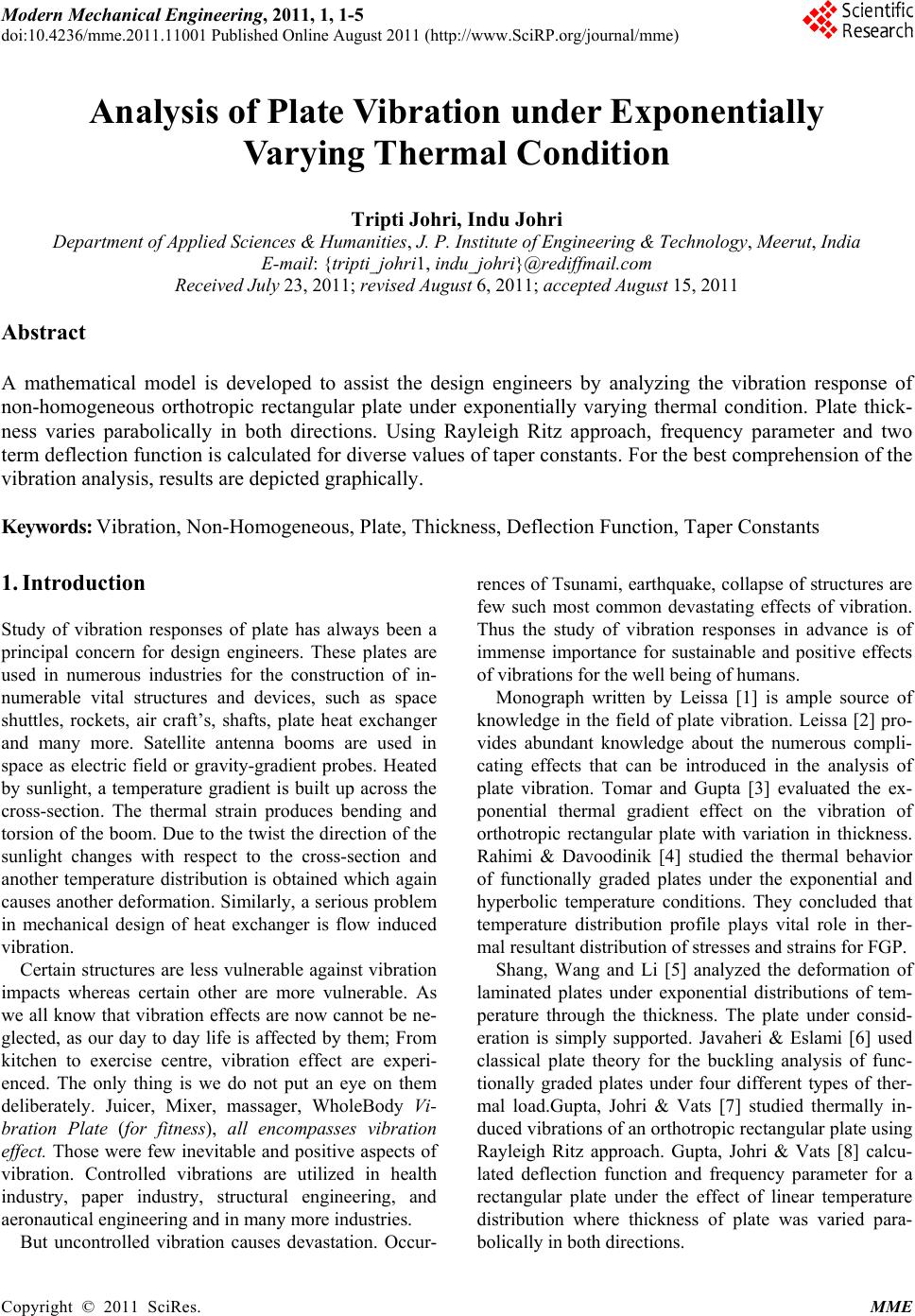
Modern Mechanical Engineering, 2011, 1, 1-5
doi:10.4236/mme.2011.11001 Published Online August 2011 (http://www.SciRP.org/journal/mme)
Copyright © 2011 SciRes. MME
Analysis of Plate Vibration under Exponentially
Varying Thermal Condition
Tripti Johri, Indu Johri
Department of Applied Sciences & Humanities, J. P. Institute of Engineering & Technology, Meerut, India
E-mail: {tripti_johri1, indu_johri}@rediffmail.com
Received July 23, 2011; revised August 6, 2011; accepted August 15, 2011
Abstract
A mathematical model is developed to assist the design engineers by analyzing the vibration response of
non-homogeneous orthotropic rectangular plate under exponentially varying thermal condition. Plate thick-
ness varies parabolically in both directions. Using Rayleigh Ritz approach, frequency parameter and two
term deflection function is calculated for diverse values of taper constants. For the best comprehension of the
vibration analysis, results are depicted graphically.
Keywords: Vibration, Non-Homogeneous, Plate, Thickness, Deflection Function, Taper Constants
1. Introduction
Study of vibration responses of plate has always been a
principal concern for design engineers. These plates are
used in numerous industries for the construction of in-
numerable vital structures and devices, such as space
shuttles, rockets, air craft’s, shafts, plate heat exchanger
and many more. Satellite antenna booms are used in
space as electric field or gravity-gradient probes. Heated
by sunlight, a temperature gradient is built up across the
cross-section. The thermal strain produces bending and
torsion of the boom. Due to the twist the direction of the
sunlight changes with respect to the cross-section and
another temperature distribution is obtained which again
causes another deformation. Similarly, a serious problem
in mechanical design of heat exchanger is flow induced
vibration.
Certain structures are less vulnerable against vibration
impacts whereas certain other are more vulnerable. As
we all know that vibration effects are now cannot be ne-
glected, as our day to day life is affected by them; From
kitchen to exercise centre, vibration effect are experi-
enced. The only thing is we do not put an eye on them
deliberately. Juicer, Mixer, massager, WholeBody Vi-
bration Plate (for fitness), all encompasses vibration
effect. Those were few inevitable and positive aspects of
vibration. Controlled vibrations are utilized in health
industry, paper industry, structural engineering, and
aeronautical engineering and in many more industries.
But uncontrolled vibration causes devastation. Occur-
rences of Tsunami, earthquake, collapse of structures are
few such most common devastating effects of vibration.
Thus the study of vibration responses in advance is of
immense importance for sustainable and positive effects
of vibrations for the well being of humans.
Monograph written by Leissa [1] is ample source of
knowledge in the field of plate vibration. Leissa [2] pro-
vides abundant knowledge about the numerous compli-
cating effects that can be introduced in the analysis of
plate vibration. Tomar and Gupta [3] evaluated the ex-
ponential thermal gradient effect on the vibration of
orthotropic rectangular plate with variation in thickness.
Rahimi & Davoodinik [4] studied the thermal behavior
of functionally graded plates under the exponential and
hyperbolic temperature conditions. They concluded that
temperature distribution profile plays vital role in ther-
mal resultant distribution of stresses and strains for FGP.
Shang, Wang and Li [5] analyzed the deformation of
laminated plates under exponential distributions of tem-
perature through the thickness. The plate under consid-
eration is simply supported. Javaheri & Eslami [6] used
classical plate theory for the buckling analysis of func-
tionally graded plates under four different types of ther-
mal load.Gupta, Johri & Vats [7] studied thermally in-
duced vibrations of an orthotropic rectangular plate using
Rayleigh Ritz approach. Gupta, Johri & Vats [8] calcu-
lated deflection function and frequency parameter for a
rectangular plate under the effect of linear temperature
distribution where thickness of plate was varied para-
bolically in both directions.